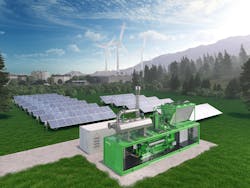Simulating real world requirements
While renewable energy technologies are at the forefront of the global energy transition, the volatile and unpredictable nature of these energy sources is leading to a gradual reduction in short- and long-term grid stability. Combined with dispatchable combined heat and power (CHP) units, battery storage and smart controls, the lack of inertia can be compensated. Microgrid technology will play an important role in the world’s energy transition by enabling higher renewable adoption.
INNIO is demonstrating the energy turnaround at the INNIO360 Energy Lab, ensuring that microgrids can meet real world requirements. This lab allows us to test new technologies and verify our microgrid control and AI-based myPlant Optimization energy management solution while meeting the entire heat and power demand of our production and office site in Jenbach, Austria. The lab includes a fully integrated microgrid that combines PV, battery storage, CHP units, power to heat modules, and electrolyzers at a later stage, to build the energy systems of the future. The microgrid increases the resilience of our production facility as well as lowering our energy costs and reducing our Jenbacher production site’s carbon footprint, with the ability to simulate and verify all possible customer requirements under real conditions.
Dispatchable Energy
Microgrids not only ensure continuous operation during grid outages, but also stabilize the utility grid, reducing outage risk. There is a need for reliable dispatchable energy sources as renewable energy sources are both volatile and not dispatchable. Microgrids achieve environmental targets without compromising resilience. Operated with renewable gases, or hydrogen as it becomes more commercially viable, gas engines are a dispatchable solution to the challenge of combining resilience and sustainability in a single distributed energy resource (DER). As a result, both gas gensets and CHP units are key DERs to providing secure, economical, and green energy when renewables are not available while pushing even further the adoption of renewable energy resources.
CHP solutions in Microgrids
Companies and communities acknowledge the importance of becoming more environmentally responsible, meet progressive regulations and requirements, and realize ESG targets.
CHP simultaneously produces heat and power from a single energy source. In addition to efficient electricity production, CHP systems convert the waste heat created during an engine’s operation into useful hot-water or steam. It is generally more efficient compared to the separate generation of electricity and thermal energy. CHP solutions work with a total efficiency of up to 95%. As a result, it helps your microgrid with CHP solution to be more efficient and decrease your carbon footprint.
If additional cooling is required, trigeneration systems can be integrated. Combined cooling, heat, and power (CCHP) solutions are a combination of CHP technology and absorption chillers, offering an efficient solution for generating air conditioning and/or refrigeration. Absorption chillers provide an economic and environmental alternative to conventional refrigeration with compression chillers. CCHP solutions enable excellent total efficiency, elimination of HCFC/CFC refrigerants, and reduction of emissions.
Finally, one very important aspect of microgrids is the use of renewable gases. Engines like those offered by INNIO’s Jenbacher brand do not only run efficiently on pipeline gas, but they also run with renewable gases such as biogas, landfill gas, and sewage gas, or even hydrogen, helping end-users to achieve their environmental targets.
Controls and Digital Solutions for Microgrids
Innovative digital solutions will enable microgrid operators to control, manage, and optimize energy assets and lower carbon footprint.
The microgrid controller, acting as the brain of the microgrid, integrates and manages a wide selection of DERs such as CHP, renewables and storage devices while ensuring high power reliability and plant uptime. Located on site, the controller is designed to maintain the stability of the microgrid including the DERs and loads in all operating conditions. In island mode, the microgrid controller supports its highest priority—power reliability—by maintaining frequency and voltage for any given load scenario, optimizing use of the connected DERs for maximum resilience to prevent an outage.
Economics of microgrids can be further enhanced by artificial intelligence (AI)- solutions that empower you to precisely understand the operational requirements of your entire plant while also increasing resilience and improving your overall balance sheet. This type of solution takes a holistic approach including real-time data, improving the operational efficiency of entire plant portfolios— from engine and heat pump to heat storage and the photovoltaic system—while taking operational requirements and annual targets into account.

